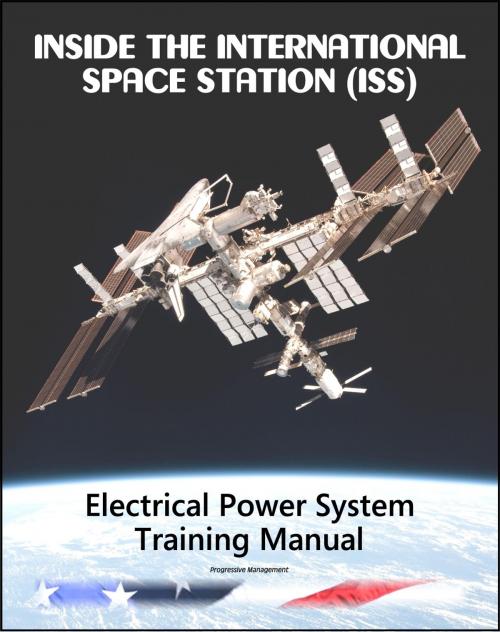Inside the International Space Station (ISS): NASA Electrical Power System Astronaut Training Manual
Nonfiction, Science & Nature, Science, Physics, Astronomy| Author: | Progressive Management | ISBN: | 9781466036161 |
| Publisher: | Progressive Management | Publication: | December 15, 2011 |
| Imprint: | Smashwords Edition | Language: | English |
| Author: | Progressive Management |
| ISBN: | 9781466036161 |
| Publisher: | Progressive Management |
| Publication: | December 15, 2011 |
| Imprint: | Smashwords Edition |
| Language: | English |
Learn about the International Space Station (ISS) from the textbooks used by the astronauts! These astronaut and flight controller training manuals, produced by the Mission Operations Directorate (Space Flight Training Division branch) at NASA's Johnson Space Center, represent a major part of the formal flight crew training process. The manuals and workbooks are extremely detailed and comprehensive, and are designed for self-study. A full listing of all acronyms and abbreviations used in the text is included. They provide a superb way to learn about Station systems, hardware, and operational procedures. Special emphasis on crew interaction with the displays, controls, and hardware is included.
This training manual covers the ISS electrical power system (EPS). The International Space Station (ISS) requires electrical power for all ISS functions: command and control, communications, lighting, life support, etc. Both the Russian Orbital Segment (ROS) and U.S. On-orbit Segment (USOS) have the capability and responsibility for providing on-orbit power sources for their own segments, as well as power sharing, as required, to support assembly and ISS operations for all International Partners. The ROS and USOS Electrical Power Systems (EPSs) are responsible for providing a safeguarded source of uninterrupted electrical power for ISS. To accomplish this, the EPS must generate and store power, convert and distribute power to users, protect both the system and users from electrical hazards, and provide the means for controlling and monitoring system performance. These functions are performed by several pieces of interrelated ISS hardware/software, which are each discussed in detail in Section 2. However, to provide the proper context for the detailed discussion, it is helpful to take a "big picture" look at the EPS system, its responsibilities, architecture, and components.
The USOS EPS is designed to be a distributed power system; i.e., power is produced in localized areas and then distributed to various modules. This functional design is similar to the process used by municipal electric utilities to provide electrical power to users.
High voltage power or "primary power" is generated in a centralized power plant and distributed throughout the area via transmission lines.
Before power is delivered to users, the voltage is stepped down by a transformer to the user-required regulated voltage level.
"Secondary power" (power transmitted at the user-required voltage level) is distributed to nearby locations and is further divided and routed by distribution boxes to provide electricity to many individual users.
An analogous process is used on ISS. USOS EPS design incorporates modules (called Photovoltaic Modules) that are dedicated to generating and storing power. These modules or "power plants" provide two sources of primary power (160 V dc) called power channels. During both insolation and eclipse, each power channel provides a continuous supply of power for distribution throughout ISS. Primary power is then converted to secondary power (124 V dc) in proximity to its intended users. From the converters, secondary power is distributed along a variety of paths to individual ISS power users. This two-level power system allows EPS to compensate for factors such as line losses, hardware degradation, and solar array aging within the primary power system while providing consistent secondary voltage for ISS users. Per this distributed design, primary power is used when transmission over significant distances is required and secondary power is for distribution locally.
Learn about the International Space Station (ISS) from the textbooks used by the astronauts! These astronaut and flight controller training manuals, produced by the Mission Operations Directorate (Space Flight Training Division branch) at NASA's Johnson Space Center, represent a major part of the formal flight crew training process. The manuals and workbooks are extremely detailed and comprehensive, and are designed for self-study. A full listing of all acronyms and abbreviations used in the text is included. They provide a superb way to learn about Station systems, hardware, and operational procedures. Special emphasis on crew interaction with the displays, controls, and hardware is included.
This training manual covers the ISS electrical power system (EPS). The International Space Station (ISS) requires electrical power for all ISS functions: command and control, communications, lighting, life support, etc. Both the Russian Orbital Segment (ROS) and U.S. On-orbit Segment (USOS) have the capability and responsibility for providing on-orbit power sources for their own segments, as well as power sharing, as required, to support assembly and ISS operations for all International Partners. The ROS and USOS Electrical Power Systems (EPSs) are responsible for providing a safeguarded source of uninterrupted electrical power for ISS. To accomplish this, the EPS must generate and store power, convert and distribute power to users, protect both the system and users from electrical hazards, and provide the means for controlling and monitoring system performance. These functions are performed by several pieces of interrelated ISS hardware/software, which are each discussed in detail in Section 2. However, to provide the proper context for the detailed discussion, it is helpful to take a "big picture" look at the EPS system, its responsibilities, architecture, and components.
The USOS EPS is designed to be a distributed power system; i.e., power is produced in localized areas and then distributed to various modules. This functional design is similar to the process used by municipal electric utilities to provide electrical power to users.
High voltage power or "primary power" is generated in a centralized power plant and distributed throughout the area via transmission lines.
Before power is delivered to users, the voltage is stepped down by a transformer to the user-required regulated voltage level.
"Secondary power" (power transmitted at the user-required voltage level) is distributed to nearby locations and is further divided and routed by distribution boxes to provide electricity to many individual users.
An analogous process is used on ISS. USOS EPS design incorporates modules (called Photovoltaic Modules) that are dedicated to generating and storing power. These modules or "power plants" provide two sources of primary power (160 V dc) called power channels. During both insolation and eclipse, each power channel provides a continuous supply of power for distribution throughout ISS. Primary power is then converted to secondary power (124 V dc) in proximity to its intended users. From the converters, secondary power is distributed along a variety of paths to individual ISS power users. This two-level power system allows EPS to compensate for factors such as line losses, hardware degradation, and solar array aging within the primary power system while providing consistent secondary voltage for ISS users. Per this distributed design, primary power is used when transmission over significant distances is required and secondary power is for distribution locally.















